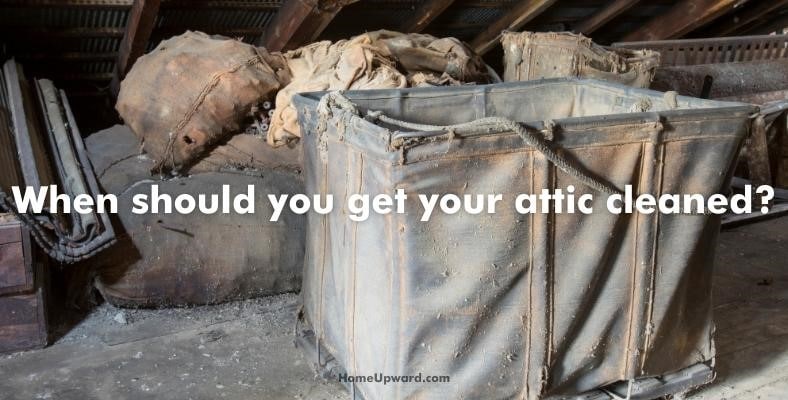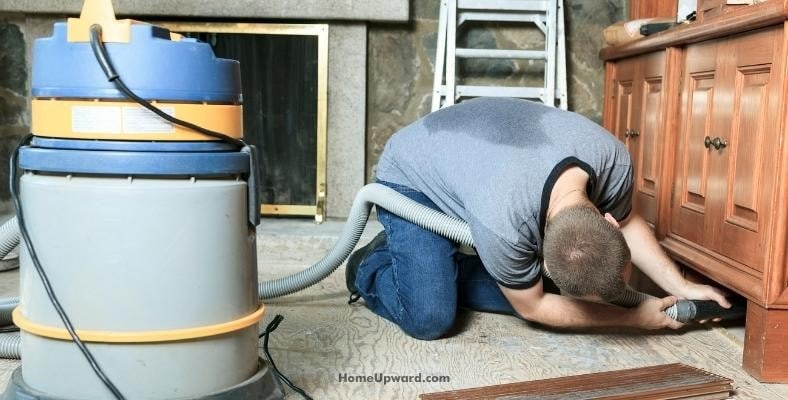Your attic is easily one of the most forgotten parts of your home. Before you decide to start cleaning it up and dealing with insulation problems, it’s a good idea to be prepared. Read on for some good ideas to help.
Contents
Attic Cleanup and Insulation Facts To Know
How Often Should an Attic Be Cleaned?
Ideally your should clean your attic at least once every two years. This cleaning schedule prevents any hazardous animals like rodents from forming large nests, which can spread diseases.
Cleaning your attic can also help with energy costs as it allows a contractor to check for any holes that are letting in moisture and air or letting heat out during cold months. In fact many home care professionals recommend not using an attic as a junk storage area as this may only exacerbate problems.
What Do You Clean an Attic With?
Cleaning the attic is something you may want to leave to the professionals, but that doesn’t mean you can’t do some cleaning yourself.
- First and foremost, wear protective gear for your eyes, mouth, and hands.
- Next, gather any cleaning essentials like a vacuum, brooms, and trash bags.
- Disinfectants are also a good idea also. A great option is vinegar to help get rid of some bacteria and viruses especially from things like rat droppings & urine.
- A duster is helpful as well. Micro fiber dusters are some of the best but you can also use clean old towels or rags as well.
How Much Does a Professional Attic Cleaning Cost?
Expect to pay around $150 and up to $1,000 (in much larger or more difficult jobs) for a professional cleaner to take care of your attic. $200 is a pretty typical amount for most people, however, so it’s within the budget of many people in fact.
The cost of hiring a professional cleaning service for your home’s attic will depend on a number of things:
- The size of the attic.
- Its overall condition.
- Any special problems like mold, pests, or physical damage you may have.
- The amount of clutter they’ll have to deal with that may be in the way.
If the attic is in poor condition or there’s a real pest problem hazard fees can raise the price even more. Things like mold, rodents, and old insulation will contribute to higher attic cleaning and insulation service prices because it’s not a part of strictly cleaning an area alone.
How Much Does It Cost To Vacuum Old Insulation From the Attic?
The average cost per foot to remove old attic insulation ranges from one to two dollars. Just like for cleaning services, there’s a number of varying factors such as size and the type of insulation.
A vacuum can remove blown-in insulation but the same isn’t true for batt insulation which requires removal by hand. Due to the variety of different types of insulation, the overall cost of removal will vary while the average is typically about $900.
How Do You Remove Attic Insulation?
As I mentioned above, removing attic insulation is usually done with a professional vacuum but some may require removal by hand for some types. Insulation removal is very often the key to attic decontamination in order for you to have a healthier living space.
Water-damaged insulation can be a breeding ground for mold and rodents will multiply if allowed.
Should I Replace Insulation After Rats?
Yes, it’s usually a good idea to replace insulation replacement immediately after discovering a rodent infestation. Some rats and mice are carriers of Hantaviruses, a type of virus spread by rodents that causes a range of different symptoms.
However, if the rat infestation was fairly small you may be able to replace a small portion after decontamination, rodent proofing, and making sure there isn’t any more risk left.
Fever, rash, fatigue, and nausea are some of these symptoms. Professionals should clean any rodent droppings or remnants, as inexperienced cleaners could put themselves in danger.
What Is Hantavirus Pulmonary Syndrome (HPS)?
Hantaviruses are a type of virus spread by some rodents. Hantavirus Pulmonary Syndrome (HPS) is a dangerous respiratory disease transmitted to people via breathing in the airborne virus.
This disease can spread to anyone who has been in contact with the rodents that carry it and has a fatality rate of a whopping fifty percent! The good news is that it’s preventable by proper rodent control & cleaning in areas that may lead to exposure.
How Much Does It Cost To Remove Rats?
Extermination costs can be low compared to the replacement costs of things like insulation. To expertly remove rodents from your attic, you’ll pay between $172 and $520, averaging around $350.
In more extreme circumstances this price can rocket to over $1000. Services like this aren’t only extermination though as many exterminators will also provide prevention methods.
How Can I Get Rid of My Rodent Infestation?
One of the key ways to get rid of a rodent infestation without having to call a pest control service is to locate any entrances to the attic and house they may be using. Blocking these entrances will cut them off from the outside and prevent new rodents from coming in.
You can then set about on extermination using things like traps or poison.
Setting up traps works fine but is a bit better suited to smaller rat populations. It helps to deal with current infestations by taking precautions to prevent future ones. Poisons can be placed in many different areas and are usually pretty effective at killing the existing rats.
Rodent proofing is important because even if you kill all of the existing ones there’s always a chance they could come back and start reproducing again. Don’t forget that there’s a reason they got into your home in the first place!
Keep them from coming back and you’ll be able to get rid of your rat problem.
What Can I Do To Keep Rodents Away?
Scents like Cinnamon are revolting to mice so try hiding some sticks away to ward off the rodents. Vinegar is also a good option because it not only disinfects but turns away most critters.
As I mentioned already (yes, it’s important!), rat proofing means sealing off any small holes or gaps where they can get in. You’ll also want to do the following:
- Make sure mice or rats don’t have access to food, seeds, grains, or anything like that which would allow them to thrive and grow in numbers.
- The less clutter you have, the better. Rodents avoid going out in the open in many cases so the less they have to hide under or behind, the better.
Should I Remove Old Attic Insulation?
Really it depends, but removing your old attic insulation isn’t always necessary. You can keep your old attic insulation as long as it has not suffered any water damage or wasn’t affected by a rodent infestation.
In fact, it’s not unusual to add new insulation on top of the older layer as long as it meets the requirements above.
However, starting from scratch and replacing the old insulation never hurts. New insulation may help with air quality and remove unseen issues. The choice is up to you, ultimately.
When Should You Get Your Attic Cleaned?
The best seasons to clean an attic are spring and fall with moderate temperatures allowing for a much more bearable cleaning experience. As recommended previously, to help keep your attic clean you should do this at least once every two years.
Some people even recommend cleaning up to twice a year because that allows you to stay up to date on your attic’s condition and catch any problems early before they become an expensive headache.
How Much Does It Cost To Vacuum an Attic?
Attic cleaning can range anywhere from as little as $150 to as much as $1000, possibly even more. Many of the same stipulations apply to generic attic cleaning as with vacuuming insulation: things like wetness and water damage, air quality, and rodents can hike up certain costs.
How Do You Disinfect an Attic?
If a full deep clean attic decontamination is necessary, it’s best to use bleach or something of equal strength although vinegar is often a better choice since there’s less risk of the side effects.
To disinfect your attic using bleach:
- Brushes, fans, and a spray bottle will also be helpful.
- Ensure windows and doors are open to help with the airflow
- Clean or vacuum up dust and dirt while wearing a breathing mask and gloves if you’re dealing with rodent or other pest droppings & by-products.
- Mix about one cup of bleach with a gallon of water and get to work. You can use a spray bottle to make applying your cleaning solution easier.
- Clean and scrub any of the residue left behind by the rodents to get rid of any contamination.
- Give it time to dry fully before you continue and be sure there aren’t any bleach fumes before staying in the attic a long time afterwards.
You can do the same cleaning/disinfecting process with vinegar too, although you can increase the amount of vinegar to water if you like. In that case 2 cups mixed per gallon of water is fine.
Why You Should Clean and Decontaminate Your Attic
Sadly, most people don’t pay much attention to the condition of their attics, allowing them to sit dormant for months or years at a time. As time goes on, animals, rodents, insects, and mold can be a problem. Cleaning and decontaminating your attic is a great opportunity to keep your home healthy and clean as well as do preventative maintenance, especially if your insulation needs attention.
Spores from mold and fungi can cause health problems along with several symptoms.. A rodent or pest infestation can also expose you to health risks from their feces or urine. It is known that some nasty diseases can be transmitted by rat droppings!
You can also boost your home’s energy efficiency by decontaminating your attic and fixing any issues you find. Keeping your home comfortable (and keeping energy costs down) requires adequate attic insulation which you definitely shouldn’t ignore.








